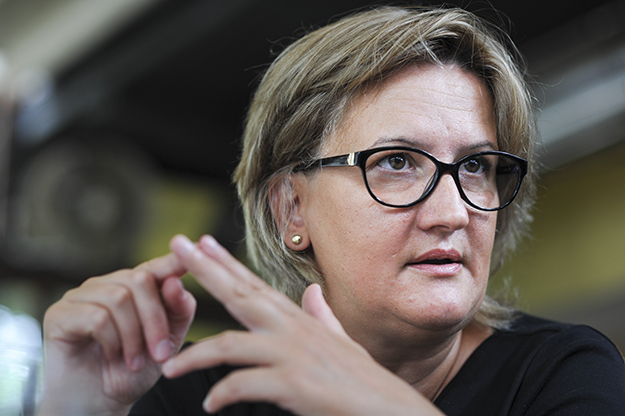In the 43 years between the Yugoslav censuses of 1948 and 1991, the number of ethnic Albanians in Kosovo increased by 220 percent, while the number of Serbs increased by only around 13 percent. There were a number of factors affecting this demographic shift, including migration. But one phenomenon was fixated on more than most: the high birth rate amongst Albanians in Kosovo.
Mimoza Dushi is a professor at the University of Gjakova that specializes in issues concerning demography. According to her, in 1950, when birth rates began to be documented more stringently, the average woman in Kosovo, of which Albanians were the vast majority, gave birth to 7.58 children. This is what is known as a ‘traditional birth rate.’
Dushi argues that the reason Albanians gave birth to many children was utterly economic. “At this time, almost the entire population was an agrarian population and lived in large families, which functioned as single households that lived and consumed together,” she says. “They were mainly engaged in agriculture and livestock — jobs that did not require skilled workers but large numbers of workers, and, to maximize the workforce, they gave birth incessantly.”
A scholar on political and sociological developments, Shkëlzen Maliqi also believes that birth rates in Kosovo have changed along with the changing ethnic structure of employment. “With the increase in employment of Albanians — especially Albanian women — as a result of industrialization and urbanization, the birth rate decreased among Albanians,” he explains. “Earlier, 70 percent of Kosovo’s population was a rural population, and consequently the birthrate was higher. Not because of any Albanian conspiracy, but for economic and social reasons.”
However, Serbian academic and political circles in the 1980s, which had a clear nationalist approach, had other explanations, infinitely inventing never-ending theories of the secret plans of Albanians to appropriate Kosovo through a high birth rate. In her book “Between Serb and Albanian: A History of Kosovo,” Miranda Vickers describes Serbs becoming “almost hysterical” over Albanian birth rates in the 1980s. According to Vickers, allegations emerged in Serbia that “the state, with its welfare benefits and money poured into Kosovo, encouraged Albanians to breed themselves into a majority population.”
By 1990, the Serbian Parliament, which had jurisdiction over Kosovo after Kosovo’s autonomy within Yugoslavia was stripped in the previous year, began to take action. According to Howard Clark’s book “Civil Resistance in Kosovo,” Article 91 of the Serbian parliament’s Programme for Peace, Liberty, Equality, Democracy and Prosperity promised ‘the necessary activities’ to bring down the birth rate in Kosovo.

Shkëlzen Maliqi has tracked sociological developments throughout the 20th century, and believes that fixations on demography and birth rates are deep rooted in Serbian nationalism. Photo: Atdhe Mulla / K2.0.
Maliqi traces Serbian nationalist fixations on population demographics back even further. He highlights the thinkings of Vaso Čubrilović, who in 1937 gave a speech to the Serbian Cultural Club outlining possible methods the Yugoslav government could use in coercing Albanians to leave Kosovo. In the speech, Čubrilović made specific reference to the “fecundity of Albanian women.”
Later, in a memorandum titled “The Minority Problem in the New Yugoslavia” and presented to the Communist authorities in 1944, Čubrilović advised Tito’s government to expel all of Yugoslavia’s Germans, Hungarians, Italians, Romanians and Albanians. After World War II, Maliqi highlights assimilation policies that also pushed for changes in demographics, including the crackdown on dissidents by Yugoslav Vice-President Aleksandar Ranković.
However, while policies addressing demographics had previously tended toward expulsions and encouraged emigrations, it was the 1960s that both Dushi and Maliqi highlight as the point when a specific focus was placed on birth rates.
Dushi believes that this in part came about due to the more benign notion of family planning, introduced to Yugoslavia in the 1960s. “Planning a family is when a couple gave birth to a desirable number of children so that a woman is not deprived either of her motherhood nor of the work she does,” the professor explains. “But in the spirit of family planning, politics has tried to seek to reduce the birth rate.”
Maliqi meanwhile points to a speech made to the Central Committee of the League of Communists of Serbia in May 1968 by one of its members, Dobrica Ćosić, who raised concerns over the enormous demographic growth of the Albanian population in the Republic of Serbia, insisting that the Yugoslav Federation take action or risk losing Kosovo — a seed of the notion that would gain traction in the 1980s.
By that time, the idea of Kosovo being flooded with Albanians due to a high birth rate was not just the preserve of Serbian nationalists. International media, including the New York Times and the Washington Post, both attributed high birth rates amongst Kosovo Albanians as a cause of the rising tensions in the province in the years following the death of Yugoslav President Josip Broz Tito. The Washington Post even reported that Albanians became the majority in Kosovo in the 1950s due to a high birth rate, while a 1948 census showed that even two years before the decade started, Kosovo contained approximately 172,000 Serbs and 500,000 Albanians.
By the 1990s, this rhetoric had become part of the state education system. Writing about the division of the Kosovo education system into two separate ethnic strands in her book “Kosovo: The Politics of Identity and Space,” Denisa Kostovicova documents that the Serbian geography curriculum included the study of measures adopted by the Serbian Parliament to control the Albanian birth rate in Kosovo.
Kostovicova also states that “the Serbs had pinpointed Albanians’ high birth rate in Kosovo as being directly in the service of the Albanian demographic conquest of Kosovo,” and that this knowledge had been used to target the Gynaecological and Maternity Clinic of the Medical Faculty in Pristina, turning even the act of giving birth into a political issue.

Anthropologist Nita Luci states that the othering of Albanians in Kosovo in the ’90s through their biology is typical of persecuted groups across the world. Photo: Majlinda Hoxha / K2.0.
Anthropologist Nita Luci says that the fixation on birth rates among Kosovar Albanians at the end of the 20th century was born at a certain political moment, and was in function of the political propaganda of that time, promoted by both the Serbian Academy of Sciences and Arts (SANU) and the Serbian Orthodox Church.
“Much of this propaganda also took kind of a racist direction by hyperbolizing the idea that Albanians are intentionally giving birth to many children, which certainly recalls similar approaches to minorities in the U.S., Australia, Canada, etc. and many campaigns for the sterilization of women around the world as a political tool,” Luci says.
She adds that it is a characteristic of nationalism that the other is attacked first in their biology. “In the case of Kosovo, it could be distinguished that it also had to do with a paranoia installed from the top, since actually the birth rate of urban women in Kosovo was not different from the birth rate of urban women in Serbia [in the 1990s].”
The anthropologist believes that it is impossible to separate the national aspect from feminist criticism in this case. “It is impossible to relativize the gender role usually given to women by nationalistic ideologies: the mothers of the nation, the biological and cultural reproducer of the nation,” she argues. “There can be found the reasons for the attacks on women, in the case of Kosovo with labels like ‘child machines’ or ‘cats.’”
Luci also emphasizes that in this notion may also be found the grounds for the use of sexual violence as a weapon in many wars, including those in Kosovo and Bosnia, because fighting women was thought to be fighting the nation’s ‘cradle.’
A contemporary issue
The fixation on birth rates and demographics did not die in the wars of the ’90s and have continued to haunt politics in the Balkans — especially Serbian politics. Since 1992, Serbia has annually seen more deaths than births. In the period between 1999–2015 Serbia had 1,748,487 deaths and only 1,205,225 births, which brings about a cumulative deficit of 539,262.
To address this trend, Serbia has appointed a minister without portfolio with responsibility for population policies. According to this new minister, Slavica Đukić Dejanović, Serbia is losing 35,000 inhabitants every year and, at the end of last year, she announced that the Serbian government will allocate 600 million Serbian dinars for population policies.
The topic has raised a lot of debate in Serbia, where Prime Minister Ana Brnabić herself has said the state should offer more social assistance rather than idle slogans to encourage population growth.
This summer, it was reported that the Serbian government will give more funds to parents who have 3 or more children, echoing a ’90s policy in which local authorities awarded medals to Kosovo Serb mothers with four or more children, as reported by the Politika newspaper in June 1993. Two years later in 1995, the Serbian Orthodox Church, also awarded medals to Kosovar Serb mothers with the most children.
The Serbian Orthodox Church continues to promote policies that expand the population today. Patriarch Irinej in a meeting with President Vučić raised the alarm of low birth rates amongst Serbian mothers, while Bishop Amfilohije publicly accused Serb women of being mass murderers of unborn children, claiming that “they’ve killed more children in the wombs in a year than Mussolini, Hitler, Tito and Kosovo Albanians together.”
Nita Luci feels that in fact, the same criticism can be applied to the Serbian state and church’s approach to Serbian women today as to Albanian women in the ’90s. “Just as once there was pressure on Albanian women for children being born, today the pressure is on Serb women because they are not having enough children,” she says. “Again, we have an essentialization of the role of women in society according to the national perspective.”
Luci also argues that in the recent case in Serbia, it emerges that nationalism often excludes and labels as enemies even internal elements, not just the foreigner. “Elements that, according to nationalism, are not sufficiently serving the sublimation of the nation and its interests. Not only women, but also other communities – LGBT, radical leftists, anti-war groups, and so on – are often seen as traitors when they do not fit the dominant nationalist ideology.”

While some statistics suggest the birth rate is decreasing in Kosovo, demographer Mimoza Dushi sees no cause for alarm. Photo: Atdhe Mulla / Kosovo 2.0.
Kosovo is also facing declining level in its birth rates. While in 1989, 56,000 babies were born in Kosovo, in 2014 only 27,000 babies were born. A report from the Kosovo Agency of Statistics, predicted that from a 2011 average of about 2.4 children per woman (that reaches child bearing age), there will be a linear decrease to an average of 1.5 children per woman in 2031.
But for the demographer Mimoza Dushi, the situation is not alarming. “In Kosovo we have an increase rate in replacement level,” she explains. “The scale is 2 or 2.1. This is not about the influence of politics, but it is about the fact that we are the youngest population in Europe. For example, 39 percent of the population are under the age of 18. All these children have potential to be parents in the future. We are a traditional society, and today it does not happen that our children renounce marriage or family creation.”
Despite Dushi’s assurances there does seem to be some concern within the ranks of the Kosovo government regarding natality. When discussing future parental leave policies with government officials, activists from civil society have revealed to K2.0 that the subject of protecting Kosovo’s birth rate was often brought up in meetings.
Disputed territories
Between Kosovo and Serbia lay two territories contested by both sides — the north of Kosovo and the Presheva Valley. Moreover, the eventual exchange of these two territories has been the leitmotif of this year’s politically hot summer, with some media in Kosovo even redrawing maps in order to dot the i’s and cross the t’s. One argument made for the case of exchange was migration and the decrease of the Albanian population in the Valley and the Serb population in the North. Demography again.
According to a 2008 survey conducted by the demographer and former head of the Kosovo Academy of Sciences and Arts, Hivzi Islami, there is a declining population in the Presheva Valley, especially after the 2000-2001 conflict, as well as in the Serb-inhabited northern municipalities of Kosovo, which are faced with lower birth rates than death rates.
During Serbian President Aleksandar Vučić’s last visit to Kosovo, he said that Serbs can win, among other things, through children, while in a published video he warns that “if we do not take action, we will disappear as a people.”
Shkëlzen Maliqi sees these statements more “in relation to the internal opinion in Serbia and as an incentive for population growth in Serbia.” Mimoza Dushi agrees saying: “These statements are simply a population policy to convince his people to give more births, he uses this panic.” Hence, while politics used the previous demographic boom as a false flag towards its goals during the 1980s, today it seems like it will use the demographic nadir as a false flag for its current agenda.K
Feature image: Creative commons

